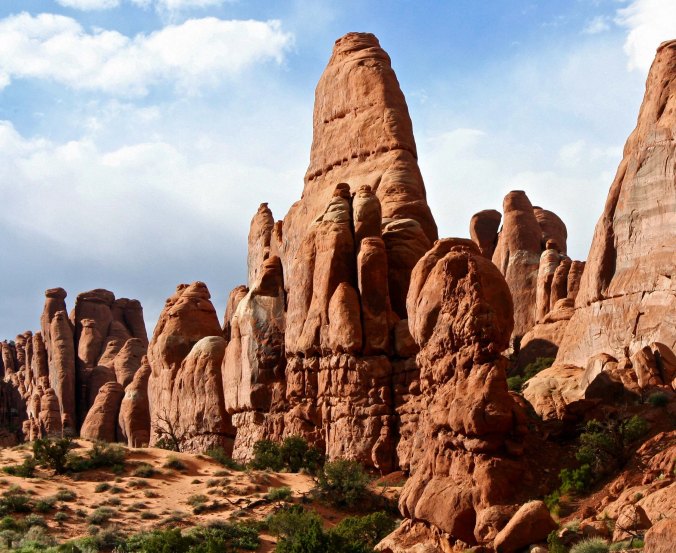
The red rock sculptures of the Southwest US are both beautiful and strange, firing our imagination while calming our souls. Few areas capture this paradox as well as Arches National Park. It is one of our favorite places.
“The desert wears… a veil of mystery. Motionless and silent it evokes in us an elusive hint of something unknown, unknowable, about to be revealed. Since the desert does not act it seems to be waiting — but waiting for what?” – Edward Abbey, 1968 in his book Desert Solitaire where he recounts his two years, 1956-57, as a park ranger in Arches.
I have a confession to make. I suggested in my last post that I was going to feature the petroglyphs of Utah’s Arches National Park next— and there are petroglyphs there that I will include in this series. But my real reason for posting on Arches was that I wanted an excuse to revisit our last trip there and share the beauty of the area with you. Peggy and I had been on our way to a private raft trip on the Colorado River through the Grand Canyon when we stopped off at Arches. The clock was ticking. Consequently, we had been forced to rush through the park. Selecting and preparing the photos for this series on Arches allows me to relive the experience at a more leisurely pace.
Arches is known for its graceful arches: There are some 2,000 scattered throughout the park. But there is much more to Arches that arches! This beautiful red rock country also includes pinnacles, balanced rocks, spires, domes and fins— all of which I will be sharing.
Geologically speaking, we have to go back some 300 million years to discover the beginning of the forces that created Arches. The area was part of an extensive sea at the time, a sea that would retreat and refill some 29 times, leaving behind layers of salt several thousand feet thick. Eventually, the mountains and highlands that surround the region eroded away and covered the salt with multiple layers of sandstone. Since then, the salt, which is less dense than the rock, has forced the sandstone up, warping it and producing domes and mesas that have in turn been eroded away by wind, water, ice and gravity into the fantastic rock sculptures we see today.
My plan for this series is to include four posts:
- Look at domes, pinnacles and some rather impressive red rocks
- Feature balanced rocks and fins
- Introduce a few of the many arches
- Explore the surrounding country, petroglyphs and settler history
Peggy and I were sharing a camera with each of us taking shots whenever something caught our attention. We have long since lost track of who took what. So, we are sharing the photo credits.

These domes feature the two common sandstones found in Arches: The reddish entrada sandstone which evolved from desert sand and the more buff-colored Navajo sandstone.
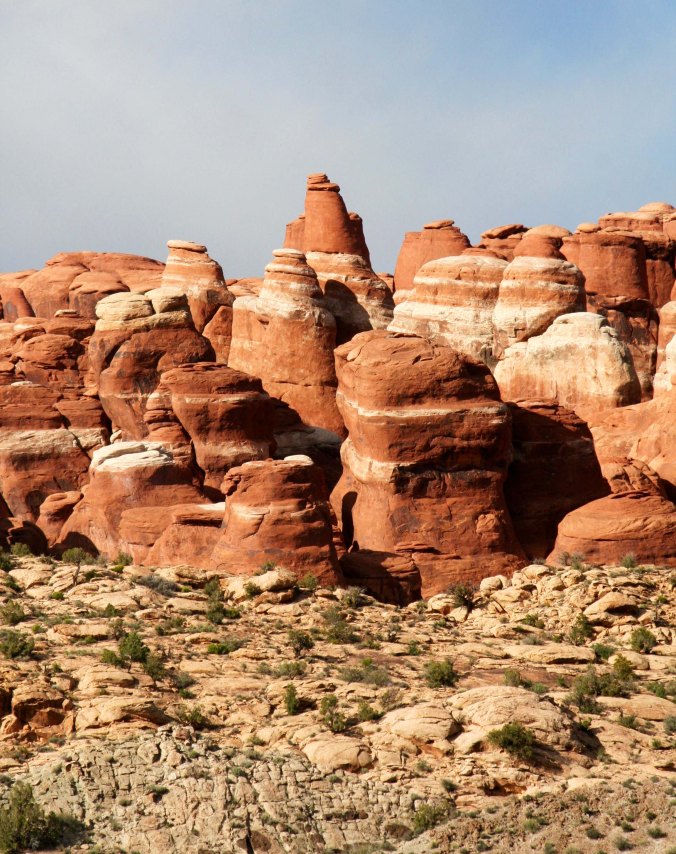
A closer look.

And closer.
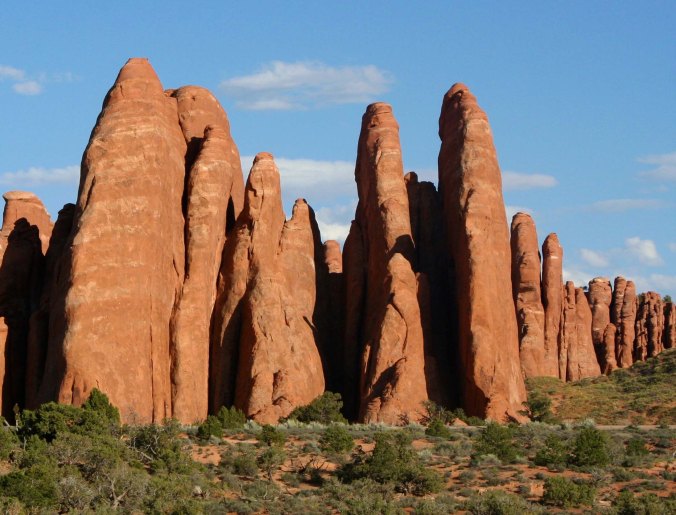
Peggy and I liked the way these pinnacles marched off into the distance.
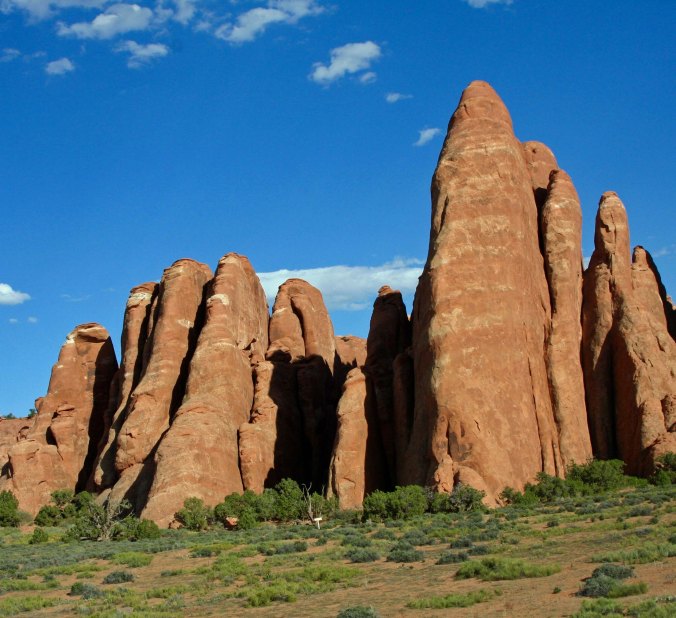
And here seemed to lean on one another for support.

In bright daylight, a family portrait.

Early morning and late afternoon adds color to the sculptures of Arches. Check out the little guy on the right with his hands in his pockets. He seems to be staring off into space. You can even see the buttons on his shirt!

More red, set off by the green of the plants that were capturing the sunlight.

Early morning light. If you make it to Arches, be sure to plan enough time there to visit during the early morning, mid-day and evening. Each will bring new treats, often giving a totally different perspective on the same rocks.
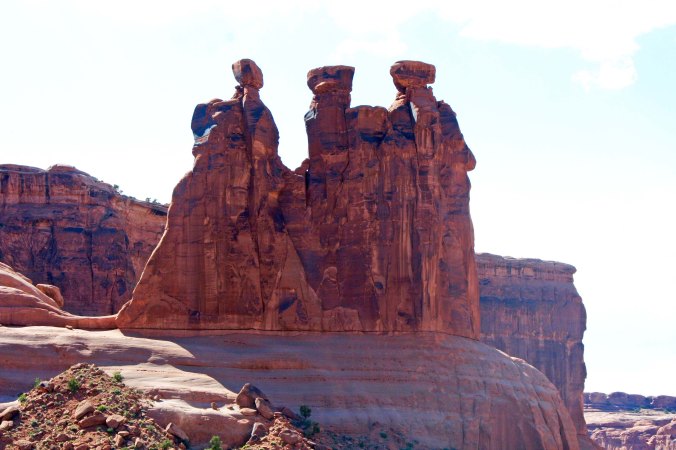
I’ll close today with the Three Gossips. Prominent rock sculptures at Arches National Park have all been named. To me, the rocks often seem to have an inner luminosity, glowing on their own!
NEXT POST: The balanced rocks and fins of Arches National Park.
It’s a unique and beautiful part of our country. My favorite is the family portrait!! Great job you two!!
Thanks, G. It is certainly a favorite of ours. Rocks don’t come any more gorgeous. –Curt
Wonderful photos. The Arches are high on our wish list.
Thanks, Peggy. Nature at her finest! –Curt
Beautiful! These really appeal to me.
It’s the sculptor in you, Hilary. 🙂 –Curt
What a great place to visit. The Utah, Arizona and New Mexico area has so much to offer. Thanks Curt for sharing these images.
This is one of our favorite places but I never took the time to understand the geology behind it. Thanks.
It’s a fascinating lab for geology, Ray. The whole Southwest is. A rock’s concept of wearing your heart on your sleeve. 🙂 –Curt
After writing and reading this, we decided it was time for a road trip again to the Arches this spring!
Yoo-hoo! 🙂
Indeed you are right there is more to the NP here.
The only thing was that regret not taking the full hike to delicate arch!
We didn’t either this time, Suan, although we did in the past and plan to this spring! There are a number of good trails in Arches. –Curt
There is always a next time!
I was there last spring, just for a couple hours, so I saw mostly arches. Thanks for this look at the other stony attractions in the park! Looks a lot like the Cappadocia region of Turkey. Thanks, Curt!
Haven’t been to Cappadocia, Kelley. Sounds like maybe I should! Our last trip to Arches was far too short as well. The first time we were there we camped and were able to hike some of the trails, an experience we intend to repeat this coming spring. –Curt
Wow! Amazing landscape.
Alison
It really is Alison… a lot of beauty and interesting geology packed into a relatively small area. –Curt
Most extraordinary structures!
Indeed, AC!
These photos are stunning. It’s been many years since I was last at Arches. I would love to get back to it some day. It’s got such a spiritual feeling.
Thank you Sylvia. “It’s got such a spiritual feeling.” Agreed. –Curt
I visited this park in1995 and I have always claimed it as possibly my favourite. Great pictures Curt and thanks for the memory nudge!
Peggy and I are seriously thinking of going back this spring. Its certainly close to the top of our favorite locations. Plus there are several other impressive National Parks in the area. Thanks, Andrew. –Curt
Spectacle and deep history … what could be better? Cheers, Curt!
Places like Arches do make blogging easy, Dave. Thanks! –Curt
How extraordinaire. Amazing sculptures by nature.
Quite so, Gerard. Mother Nature is quite talented. 🙂 –Curt
I’ve always found it quite something the way Sandstone erosion develops. Your photo’s reflect that well. Thanks for sharing them. CompassAndCamera mentioned Cappadocia, yes there is a similarity.
Thanks, Ted. I think Arches, and numerous other places in the Southwest, make great geology labs as well as being places of beauty and wonder. Cappadocia seems like a must if I make it back to Turkey. –Curt
I never tire of seeing images from the southwest generally, but Utah is one of my favorites. Sometimes I wish I’d taken the time to see more while I lived there, but I was Salt Lake City-centric, much younger, and not at all given to photography. Now, if I have the chance to go, I’ll certainly be better prepared and more able to appreciate the sights.
Utah certainly has its share of impressive National Parks, Linda, especially when it comes to admiring rock formations and appreciating geology. I made several visits to the Utah and the Southwest before I ever had a camera! But I’ve started to make up for that. We are hoping to head back to Arches this spring and I am sure we work in a few more National Parks. –Curt
The Three Gossips couldn’t have a better name!! But my favourite picture is the one with pinnacles marching off, they are so neatly aligned🙂
Some people think that they should have named the trio “The Three Wise Men,” but I though gossips worked well, Christie. 🙂 I was caught by the marching quality as well. They were all part of the same ‘fin.’ I have more examples in my next post. –Curt
Such extraordinary scenes. Almost hard to believe they are real. Kudos to both of you for these gorgeous images.
Thanks, Sue, and yes, the rock formations do have a surreal feel to them. –Curt
Curt, these are glorious!! What an amazing place and the mind boggles at the 300 million year history! The Gossip and Family group are so special and I can see what you mean about their inner luminosity…an ethereal glow. Great stopover visit and share.
Thank you, Annika. The Southwest has several gorgeous National Parks featuring various types of rock formations, ranging from what I am featuring in Arches all the way to the Grand Canyon, and each one is significantly different. Arches, I feel, is best for rock sculptures. Peggy and I seriously thinking that we want to head back there this spring. 🙂 –Curt
I just want to go somewhere Grand Canyon sometime!! 😀😀 You two have a great time seeing these in the spring…more photos??
Always more photos, Annika. 🙂 And thanks. –Curt
What an absolutely stunning place. I’d never heard of it before.
Well then, Coral. Now you can add it to your list of places to see. 🙂 Thanks for your comment. –Curt
nice photos
Thanks. –Curt
These remind me of Cappadocia in Turkey. Equally stunning.
A place of rare beauty… Thanks, Bojana. –Curt
Arches is one of our favorite national parks — and not just for the arched formations. All the spikes and curves you’ve shown are marvelous as well. As with most of the Utah parks, we noticed how the time of day could change our views and impressions of color and shapes. What a fantastic place to visit! And thanks to the park service, a very easy road to travel between photo stops!
One of ours as well, Rusha. In fact, after seeing the photos again, Peggy suggested that we head back there in the spring. 🙂 The rocks can turn from orange, to red, to looking rockish. –Curt